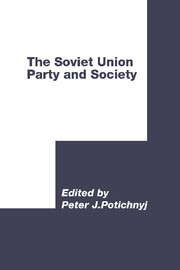Book contents
- Frontmatter
- Contents
- List of figures
- List of tables
- List of contributors
- Foreword by R. C. Elwood
- Preface by P. J. Potichnyj
- Part 1 Party apparat
- 1 The apparatchiki and Soviet political development
- 2 The primary party organizations of branch ministries
- 3 Soviet local party organs and the RAPOs
- Part 2 Socialization and political discourse
- Part 3 Social policy
- Index
- Publications from the Third World Congress for Soviet and East European Studies
3 - Soviet local party organs and the RAPOs
from Part 1 - Party apparat
Published online by Cambridge University Press: 04 August 2010
- Frontmatter
- Contents
- List of figures
- List of tables
- List of contributors
- Foreword by R. C. Elwood
- Preface by P. J. Potichnyj
- Part 1 Party apparat
- 1 The apparatchiki and Soviet political development
- 2 The primary party organizations of branch ministries
- 3 Soviet local party organs and the RAPOs
- Part 2 Socialization and political discourse
- Part 3 Social policy
- Index
- Publications from the Third World Congress for Soviet and East European Studies
Summary
The Food Program enacted by the May 1982 Plenum of the Central Committee of the Communist Party of the Soviet Union (CC CPSU) provided for new state agencies in the countryside. Ranging hierarchically from the autonomous republic to the district level, they were mandated to harmonize the activities of kolkhozes (collective farms) and sovkhozes (state farms), processing and storage plants, as well as enterprises contributing to farm operations. With powers granted by the Plenum, the associations had the potential to assume many day-to-day tasks for coordinating rural producers' activities. The new administrative entities also had the tools to address problems and opportunities of a real agricultural development. Since the availability of food and related commodities has long been a significant public policy problem in the USSR, the 1982 structural reform is of interest as a strategy for increasing production efficacy. However, creation of the agro–industrial associations was also a departure for the Brezhnev regime, because it did not undertake any other large-scale organizational alterations of the direction of rural production. Implementation of the reorganization was continued by Brezhnev's successors, so that the structural change has enjoyed at least some measure of continuing support under several leaderships.
Probably the most significant of the novel agencies approved in the Food Program was the raion agro-industrial association or RAPO. Traditionally, in Soviet agriculture, the district sub-division has been particularly significant from a management standpoint since raion authorities are closest to the actual execution of farming processes.
- Type
- Chapter
- Information
- The Soviet Union: Party and Society , pp. 48 - 64Publisher: Cambridge University PressPrint publication year: 1988



